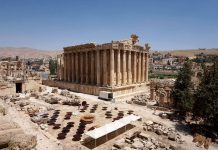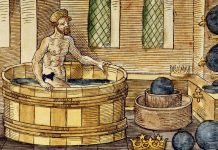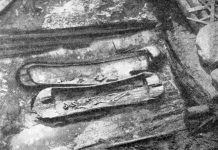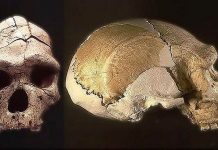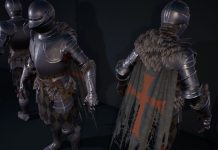When an important tribesman died, the nomads made considerable efforts to ensure a proper burial using simple tools. Among the guns are wedges with highlanders flattened by a hammer. Perhaps they were hammered into the ground to loosen it during excavation.
The scheme of all burial mounds is approximately the same. A rectangular pit was dug, which was sheathed with larch logs, obtaining a chamber for one or more bodies. The walls are often double. The floor is plank. The ceiling is covered with log rolls.
Little is known about the religion of the Pazyryk people. Herodotus wrote about the Western Scythians that “it is not their custom to erect statues of gods, altars and temples.” The personification, for example, of the god of war became an iron sword stuck in the ground-akinak, before which sacrifices were made. There are also no permanent sanctuaries found in Altai. Since the nomads had no written language, they left no religious texts.
However, a clearly ceremonial attribute was found in Pazyryk — a leather bag with nails and hair. Obviously, these are traces of a custom or ritual somehow related to magic. Indirect signs indicate a religion close to shamanism, which is still widespread in Siberia and Mongolia.
A shaman is a priest, a sorcerer and a doctor, an intermediary between the earthly and supernatural worlds. To communicate with spirits, he puts on a special outfit, often with a deer’s head or horns, eats hallucinogenic mushrooms and, beating a tambourine, falls into an ecstatic trance.
RECENT HONORS
Most likely, the funeral in Pazyryk was led by shamans. By the nature of the burials, one can judge the rituals associated with them. Probably, the graves were dug in the summer, when the soil thawed enough. The bodies were embalmed by removing the insides and muscles through incisions, and the voids were stuffed with grass. Then the skin was sewn up with tendon threads. The coffin with such mummies, obviously of the leaders and their wives, was placed in a burial dugout, decorating it with utensils necessary in the afterlife: carpets and draperies, dishes for food and drinks. Behind the partition, specially slaughtered magnificent horses were laid.
The funeral, apparently, was accompanied by a noisy party and ritual burning of hashish. Bronze censers with charred hemp seeds and pebbles were found in two Pazyryk mounds. A felt tent was specially stretched on a wooden frame so that the audience could inhale more narcotic smoke.
Herodotus writes about such fumigation after the Scythian funeral, comparing it with a steam bath. This detail completely coincides with the Pazyryk finds:
“On three support poles connected by tops, they pull woolen fabric, making sure that its pieces are connected as tightly as possible. A dish with red-hot pebbles is placed in this tent. Then they take the hemp seed, crawl inside and throw it on the pebbles.
The seed immediately begins to smoke, giving steam, which you will not find in any Greek bath. The Scythians enjoy it so much that they scream with pleasure…”
Almost certainly buried with music. Tambourines made of a membrane stretched over a horn rim were found in the graves, similar ones are still used by Asian tribes.
After paying the last respects, the grave was covered with branches and birch bark, and then with several rolls of larch logs. The excavated earth was poured on top, and then a pile of boulders up to 4.5 m high. Centuries passed, the Scythians in Altai disappeared, and stone mounds remained witnesses of their peculiar civilization.
DISAPPEARING BEAUTY
Tattoos in the form of mythical animals decorated the hands of the Pazyryk warrior (above) and the “princess” (right), recently discovered in a frozen burial in the “Heavenly Pasture” southwest of Pazyryk.



















